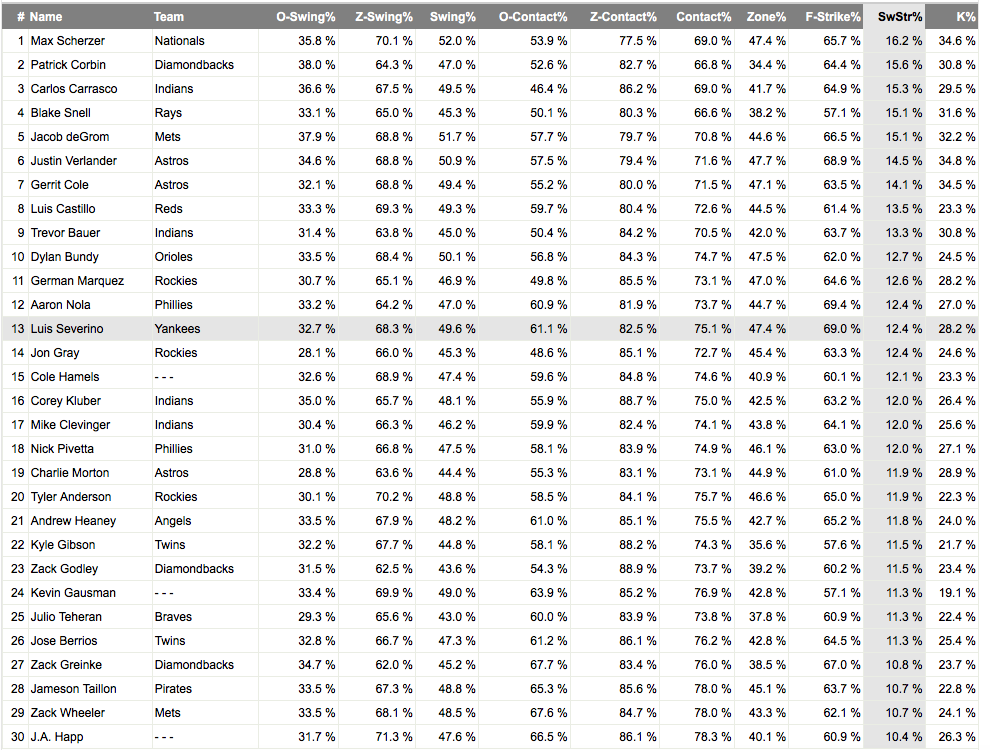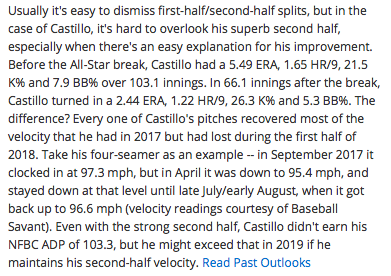Having started down this path trying to find negatives, I thought that it would be worth a look to find a few pitchers that might be underpriced by looking at their Swinging Strike Rates. My methodology will be similar - using Fangraphs.com's leader boards, I'm looking for pitchers with high SwStr%'s, comparing it to their K% and their ADP so far in the NFBC. Keep in mind right now we've only been looking at a small number of drafts, most of those in the 15-team, 50-round Draft Champions contest.
The first thing I noticed is that the SwStr% leaders correlated really well with a high K% last year:

The general idea is pretty simple - a pitcher that generates a lot of swings and misses should also generate a lot of strikeouts. It's not exactly an earth-shattering formula, and for the most part the correlation is pretty high. Of the 18 qualified (in terms of innings pitched - of the 57 I looked at, the fewest innings pitched were 161) starters that generated a 12.0% SwStr% or higher, only four had a K% below 25.0%, with the lowest of those chiming in at 23.3%.
Let's approach this two ways - first, let's look at those four pitchers at 12.0 SwStr% or higher than didn't have a 25.0 K%. After that, we'll look at the top 30 overall in SwStr% to see who falls out of the top 150 in NFBC ADP. The 150-benchmark is a bit of a selective endpoint - but I'm generally looking for starting pitchers outside of my top two, and outside of the first 10 rounds in a 15-team league.
Four K% Underperformers:
Luis Castillo (13.5/23.3) - Castillo strikes me as having the highest K% upside in this grouping. I wrote the season outlook for him, so I'm going to employ a horrible writing trick and quote myself:

When I started this piece, I thought that I'd be ahead of the consensus on Castillo, wearing my Reds-colored blinders. Alas, that's not really the case - my projection has him rated (for now, the ratings are pretty fluid) 107th overall - his NFBC ADP is 115.65. With a few good outings and radar readings this spring, I expect him to have some draft helium.
Dylan Bundy (12.7/24.5) - I bet you didn't expect to see Bundy rated so high on this list, following a season where he posted a 5.45 ERA and 1.41 WHIP. Walks weren't an issue, either - he has 7.2 and 7.3% walk rates the last two seasons respectively. Bundy's downfall was the whopping 41 homers he allowed in 171.2 innings. Generally speaking, he had good control but lousy command within the strike zone? Is this a correctable error? Would he benefit by throwing fewer strikes? I just have such a hard time squaring the high SwStr% with the HR-rate, and the fact that he lost considerable velocity on his fastball and his slider last year. I wonder if altering his pitch mix, a la Patrick Corbin in 2018, might help him out - his slider was an effective pitch last season, but he got pounded against his four-seamer and especially against his changeup. A dart throw here might still be worth your while - it's hard to ignore that K%, and young, inexperienced can learn on the job. Perhaps the sea change in management will help. You won't have to pay much for the risk - his current ADP is 304.61.
Jon Gray (12.4/24.6) - My rule of thumb has always been to let my competition take the best Rockies starters, because it's so hard to beat Coors Field. So I avoided the disappointing season by Gray last year - but I also missed out on breakouts by German Marquez and Kyle Freeland. There's so much to parse with Gray, that I don't what to emphasize. He had a midseason demotion that seemed a bit unfair, but after he returned, he had a seven-game stretch where he posted a 2.59 ERA. Unfortunately, the season continued after those seven starts and he struggled again in September, getting left off the postseason roster. He lost velocity, and he also lost 20 pounds due to health issues. Coors Field also really isn't to blame here - for the third year in a row, his road ERA (5.34) was higher than his home ERA (4.91). With an ADP of 200.57, you're not getting as much of a discount as you might have anticipated over last season (165.89).
Cole Hamels (12.1, 23.3) - Sometimes the most simple explanation holds true:
With the Cubs: 2:36 ERA, 1.10 WHIP, 24.3 K%, 0.71 HR/9
With the Rangers: 4.72 ERA, 1.37 WHIP, 22.7 K%, 1.81 HR/9
Current ADP: 143.87
Others Outside the 150:
Nick Pivetta (ADP: 157.61, K%: 27.1, SwStr%: 12.0) - Pivetta barely qualifies for this list based on ADP - it's clear that plenty of the NFBC players are onto his strikeout skills. The trends are positive here too - his HR rate dropped from 1.69 to 1.32, his walk rate dropped from 3.86 to 2.80 per nine innings, and he narrowed his LH/RH split. If there's another gradation of improvement, he could be an SP2, especially on a defensively improved Phillies team.
Tyler Anderson (ADP: 405.96, K%: 22.3, SwStr%: 11.9) - After hanging with him too long last year in the Main Event, I'm really wary here. Everything got worse after the All-Star break - ERA (6.06), HR rate (a Bundy-esque 2.02 HR/9) and K% (20.8). Yeah, hard pass here absent a compelling reason why he's got everything fixed.
Andrew Heaney (ADP: 183.17, K%: 24.0%, SwStr%: 11.8) - This is more like it. Heaney walked just 45 batters in 180 innings, made it through a healthy season for the first time since 2015, and is in a great division - four good pitchers parks, two rebuilding teams worse than the Angels. I wouldn't be surprised if he costs you somewhere around the 150th pick by March, however.
Kyle Gibson (ADP: 278.70, K%: 21.7, SwStr%: 11.5) - Nobody wants to believe in Kyle Gibson, and I understand why. He truly was dreadful in 2016 and 2017, but last year he improved his velocity, SwStr%, K% and home run rate. He induces a ton of ground balls, and is in a fantastic division. But as an illustration of how the sharps are fading him, I'm in a 15-team NFBC Draft Champions League, currently in the 21st round (i.e. past his ADP), and he's still hanging around, like the last sliver of milk in a jug that's been in the fridge for just a day or two too long.
Kevin Gausman (ADP: 208.30, K%: 19.1, SwStr%: 11.3) - This is the closest to a reverse example to yesterday's exercise - with his swinging strike rate, Gausman should have a higher strikeout rate. I often thought that Gausmania hadn't taken hold in the fantasy community because his last name autocorrects to "Gas Can" - about as bad as any pitcher name this side of Homer Bailey. But maybe it's also because his K% actually dropped upon his arrival to Atlanta, from 19.5 to 18.2.
--
A humble reminder - this is just one statistical indicator, and not the be-all, end-all guide to finding sleepers (shudder at the term, as we as an industry have shredded the meaning of "sleeper" and "bust" by now). But hopefully this is one angle you can use to find a few profitable pitchers. If you want to dig deeper using this method, try setting a lower inning threshold to expand your pool of eligible pitchers.


